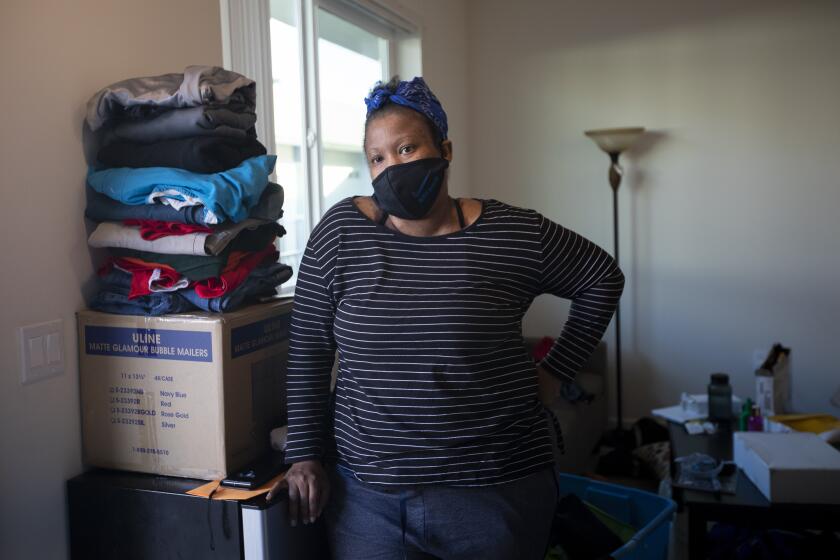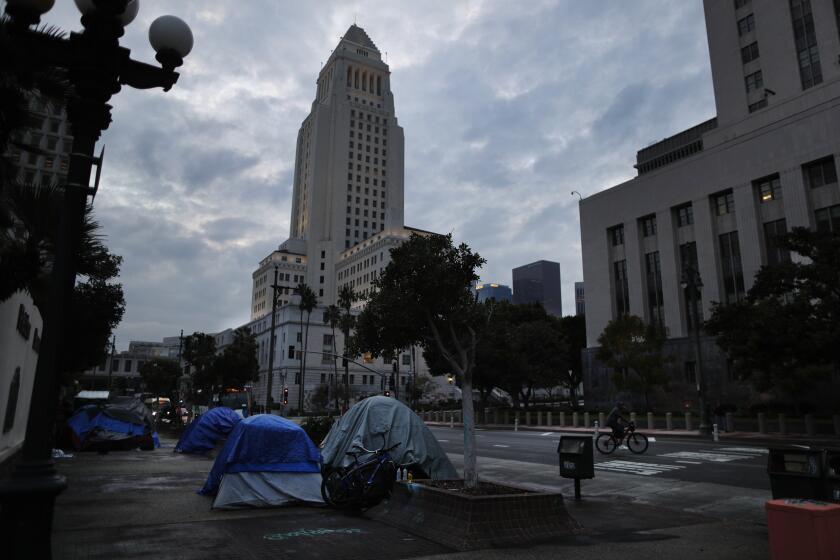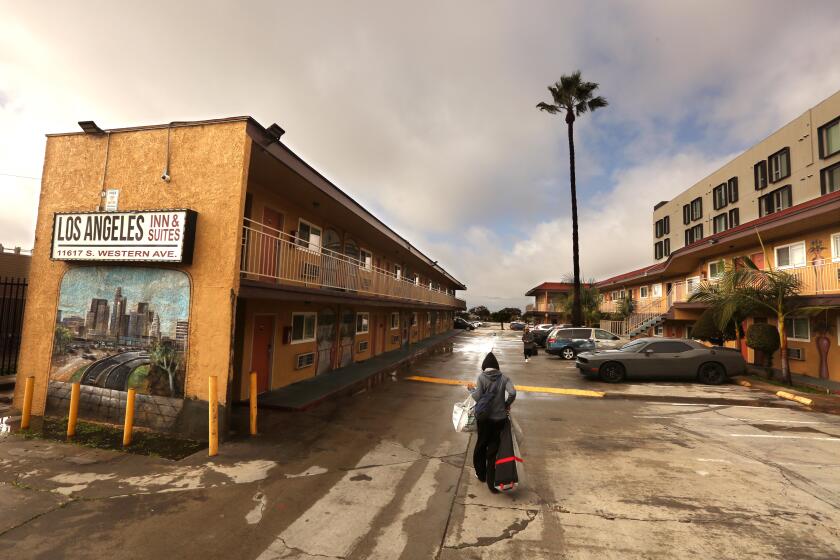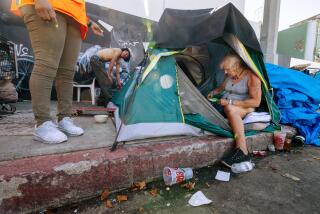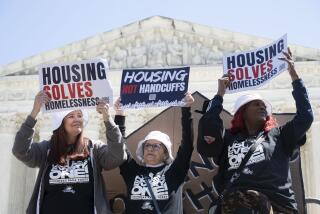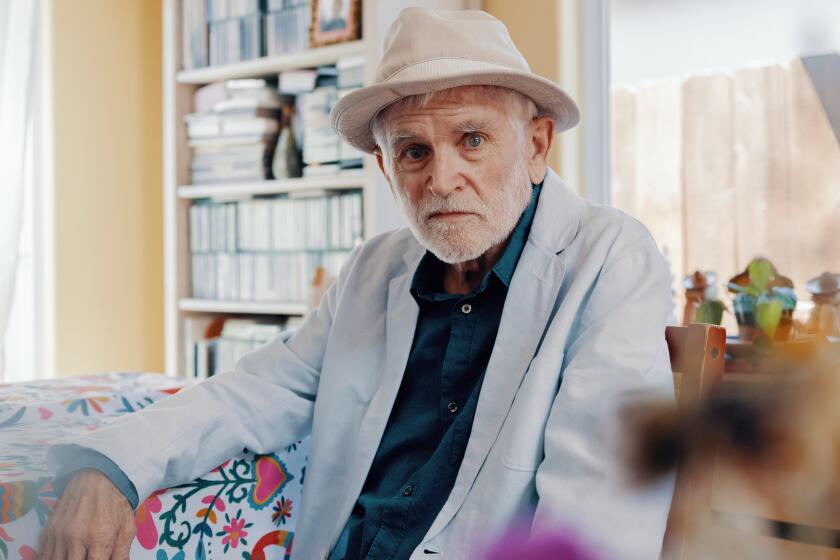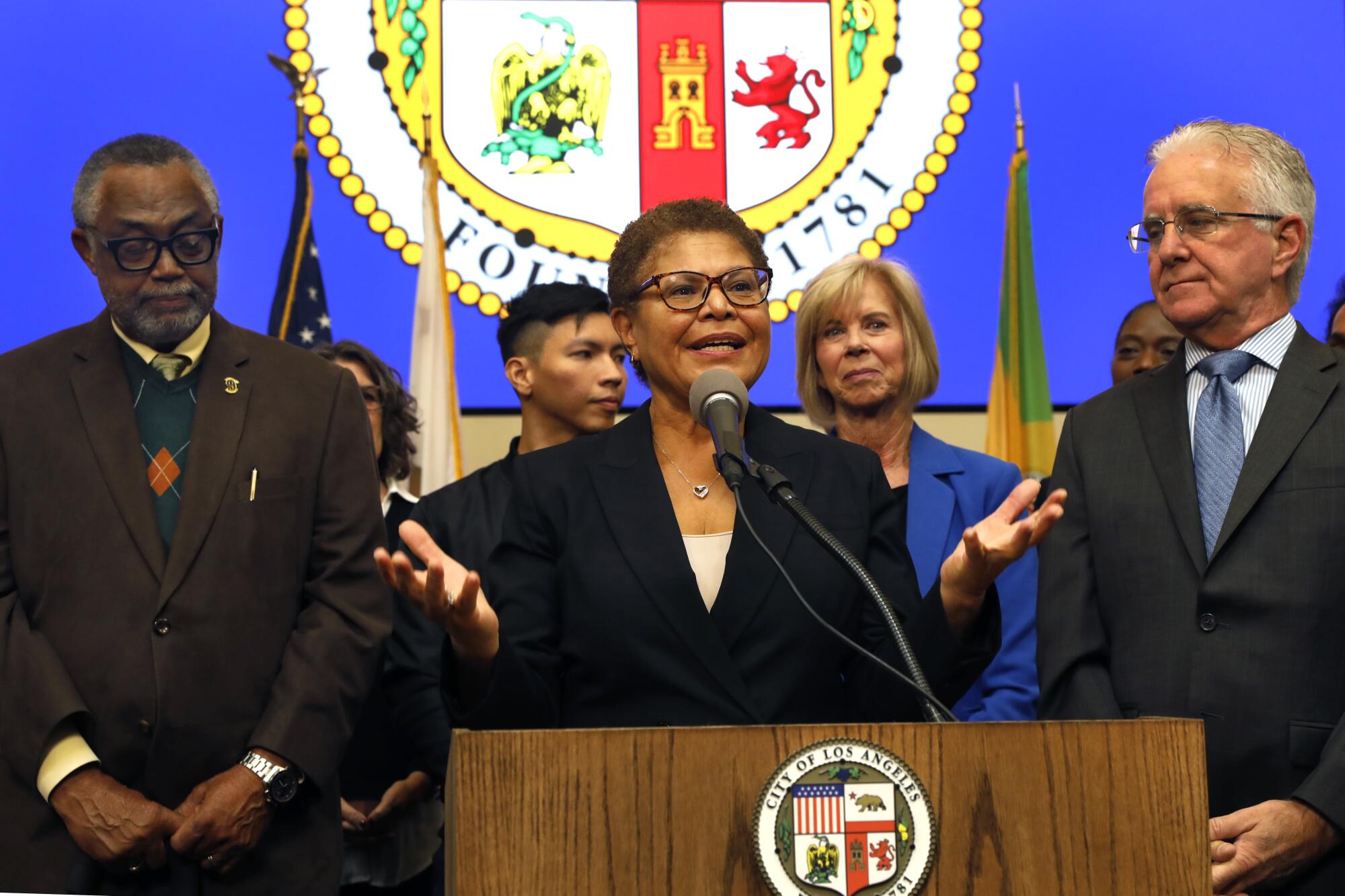
- Share via
When she was running for mayor of Los Angeles last year, Karen Bass spoke often about how the homelessness crisis is what prompted her to leave a safe seat in Congress and “come home.”
It was the crisis of our time, and now, weeks into her tenure running the country’s second-largest city, she spoke at length on “Gimme Shelter: The California Housing Crisis Podcast” about her views on a host of housing and homelessness issues.
Even though she only recently took office, Bass believes she’s already running short on time to address the problems, given that a new presidential administration could be in place in two years and opposition to a new city real estate tax remains strong.
“Who knows what’s going to happen in 2025, especially with the way the electoral process is being distorted in different states,” Bass said. “So I need to work as close as possible with the Biden administration, not knowing what’s going to happen in 2025, and I need to work immediately now on [Measure] ULA, even though the dollars aren’t available yet.”
Here are excerpts of the conversation, which took place Tuesday, edited for length and clarity.
Liam Dillon: What do you believe the most significant problem the city faces is in how it approaches housing and homelessness?
Mayor Karen Bass: I think the most significant problem that the city faces is profound income inequality. The difference in how expensive it is to live in the city now. Homelessness is just the most extreme manifestation. There’s a lot of people who are not on the street who I would still consider homeless, because there’s three and four families or several individuals living somewhere. They are together because if they weren’t together, they’d be on the street. So the difference between the haves and the have-nots to me is the fundamental problem.
LD: During the campaign, you talked a lot about how your relationships in Washington, D.C., and in Sacramento would help you address the city’s housing and homelessness problems. Now that there seems to be more scarcity on the horizon, what concretely do you expect from the federal and state governments and how do you expect to make up for these declining revenues?
A state program, Project Homekey, has resulted in one of the largest expansions in shelter for homeless people ever. Without more federal funding, it will expire.
KB: Not everything is money. We did a briefing call with the governor’s staff about the budget and they were very clear that the money for [Project] Homekey is still in place; $1 billion is still in place. Of course, we would always like to have more, but one of the cuts that they said they made was in resources for first-time homeowners. We were told that the money for homelessness is still intact.
In terms of D.C., I’m very excited that the Biden administration has said that they want to reduce homelessness by 25% in two years and so immediately I picked up the phone and said, “You want to reduce homelessness by 25% in the nation. If you take care of L.A., you can meet your goal in our city alone, but if you address California as a whole, you can surpass your goal, because we are the epicenter.”
Benjamin Oreskes: United to House L.A. [is] a huge pot of cash for the city and one that providers [and] members of your administration are really excited about. Obviously it’s early days, but can you tell us what you see as its biggest opportunities and where exactly you’re going to push people to spend the money?
KB: It is very prescriptive and sometimes you can do that and it’s good, and sometimes you can do that and it winds up putting handcuffs on you. But what I’m excited about is that the money can be used to buy housing, because that’s what we’re going to need to do. It’s one thing to have motels to do master leasing. The reality is, is that we need a constant supply.
The difference between L.A. and New York. New York has more unhoused people, but they have less street unhoused, and that’s because over the years they have acquired thousands of units of temporary housing, not congregate shelters, but hotels. That’s really where we need to go and so the fact that I could purchase, do short-term subsidies for interim housing, which is exactly what we’re doing now.
Here’s what I’m worried about. I’m worried that the real estate community is definitely going to come at this full force. So in my opinion, we have to get everything we can out of it. It’s the same way I feel about the [Biden] administration. Who knows what’s going to happen in 2025, especially with the way the electoral process is being distorted in different states. So I need to work as close as possible with the Biden administration, not knowing what’s going to happen in 2025, and I need to work immediately now on [Measure] ULA, even though the dollars aren’t available yet.
The L.A. ballot measure would add a tax to property sales of $5 million and above.
BO: You mentioned your executive order. First day in office, you followed through on your promise, as you said. Then there’s Inside Safe. This is a citywide program to identify the most challenging encampments. Both of these initiatives speak to the urgency of the moment. With ULA, a lot of the money when it comes to the housing piece is much more about the future. How do you balance the urgent needs you’re conveying with your emergency declaration, with Inside Safe and the long-term challenges the city faces?
KB: The bottom line is you got to do both. What I believe is, is that the city is demanding the tents go away. That is the way every Angeleno feels this crisis. For me, the tents represent the people who are suffering the most.
That’s why we put the city in a state of emergency, but two or three days later, I did an executive directive so that we could fast-track building. So what I like about ULA is ULA is focused on different types of housing. It is focused on workforce housing. It’s focused on affordable and it’s focused on lower income. It allows us to build the type of housing that we need or to renovate commercial properties.
That was one of the problems in [Proposition] HHH, right? HHH required new buildings.
LD: This is the billion-dollar bond measure that the city passed about a decade ago.
KB: Right, that everybody in the city is upset about because they found out that it costs to build an individual unit $700,000 or $800,000. One of the reasons for that was because of the bureaucratic process that delays everything. So my executive directive expedites that. We had the press conference at a property where they had been trying to build affordable housing for 14 years and we were at their groundbreaking. That is insanity. It has to do both.
Mayor Karen Bass’ Inside Safe initiative targeted an encampment that served as home to an estimated 98 people. By Monday, 82 had moved indoors.
LD: Do you think the city’s construction of market-rate housing helps or hurts the homelessness and housing affordability crisis?
KB: I do think the city needs everything. Well, let me let me qualify that. I’m not sure if the city needs more luxury housing. But luxury housing and market-rate housing are two different things. In some areas, there is a great need for more housing. In some areas, there’s a need for affordable housing, especially in areas that have traditionally been inner-city areas that are now being gentrified. People are being pushed out of their neighborhoods, and they don’t want to be.
I have never understood who lives in all that luxury housing. I do know that there’s a high vacancy rate, or put it this way, there’s absentee owners. People who don’t even live in the United States who own a lot of property here. That’s just hard considering all the people on the street. So the only type of housing I don’t think we have a huge need for is luxury. Maybe some but not a huge need.
LD: We’re going to give you a series of statements where you can only answer true or false. But we will allow you to add a few more words afterward to explain your point of view.
So I’ll jump off with the first one here: Rent control is a necessary part of a functioning housing system in high-cost cities like Los Angeles to protect tenants.
KB: True. We have to have rent control. People are being priced out. Some landlords are doing bad things like: “We can’t get rid of the tenants because of rent control. So I’m going to let the building completely deteriorate so it becomes unlivable and then they move.”
BO: The primary cause of homelessness is not mental health or drug abuse issues, nor is it poverty. Rather, the primary cause is the cost and availability of housing.
KB: Yes, that’s true. It is a stereotype to think that everybody that is unhoused has a mental health issue. Clearly, there’s a percentage that do. But let me just tell you something. If I was on the street long enough, I’d have a mental health problem or a substance abuse issue too.
LD: The construction of market-rate homes in disadvantaged areas does not cause gentrification or displacement, but instead prevents it.
KB: That’s false. That’s completely false. I’m sorry. The area that I lived in until a few weeks ago in South L.A. People who paid $150,000 for their homes. If you put a market-rate house next door, it’s going to be close to $1 million. The people that live in that neighborhood, just say you want to move to another house in the same neighborhood. You can’t afford it if it’s market rate.
The house I lived in — I got offers all the time. “We will give you cash money for your house.” So I watched the elders in my neighborhood sell their homes, but then their kids couldn’t come back to the neighborhood. But how do I tell them not to walk away with over a million dollars?
BO: Proposition 13 is a necessary protection for homeowners who would otherwise pay too much in property taxes.
KB: That is true, but the problem with Prop. 13 is not the residential component. It’s the commercial component. Voters didn’t realize a couple of things. No. 1, they didn’t realize that there was a carve-out for commercial property. The other thing they didn’t realize is that they changed the way the state passed a budget and it became two-thirds. That was one of the reasons why the state of California was so dysfunctional.
So fortunately, that piece of it was changed.
LD: Anything you want to leave us with?
KB: I’m so excited. I am extremely hopeful. I’m finding out all kinds of things that we can do differently, things that we can change. I’m finding things I thought were federal regulations that were actually imposed by us that can be set aside. More to come. I’m happy to share more of that later as we learn more specifically. But I think we’re going to be able to make some headway. I really do.
More to Read
Sign up for Essential California
The most important California stories and recommendations in your inbox every morning.
You may occasionally receive promotional content from the Los Angeles Times.
